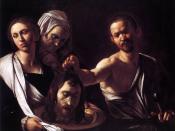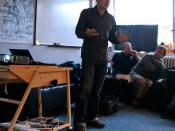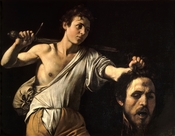The hostility Caravaggio portrayed in his paintings often alluded to the turmoil he endured in his personal escapades. His aggressive disposition was more often than not the inspiration of his work. Most of his paintings were indirect depictions of events that happened throughout his lifetime and/or the attitude expressed when the works were created. The "feverish, skyless" Caravaggio was a "violent masochist" at heart; his willingness to receive and administer pain was the "central conceit of his life and art (Sohm)." Caravaggio's outside appearance "inferred" many parallels in his artistic style. His Baroque style and use of chiaroscuro articulated the darkness of his physicality. "He had a dark complexion, and he had dark eyes, black eyebrows and hair, and these features also transpire in his manner of painting (Dell'Orto)." His demented sub-conscience was unleashed in four of his most famous paintings as well as many others. Several of his works were self-portraits that conveyed his feelings and mind set at the time of their completion.
"The Beheading of St. John", "The Martyrdom of St. Matthew", "The Martyrdom of St. Ursula", and "David with the Head of Goliath" were all animations of his fascination and fear of death.
In "The Beheading of St. John", Caravaggio's true self emerged. His homicidal fantasies and sadistic actions were the stimulation for this particular work. Caravaggio's artistic motif was also inspired by his deviant homosexual tendencies. He was irately violent as a result of his homosexuality seeing as he was probably ashamed of his sexual preference. The focal point was the crotch of the executioner. " Caravaggio excelled in portraying the bodies of muscular men (Danielsson)." Of all the figures on the huge canvas used for this painting, all the light seems to be emitted from the sexual organ...


